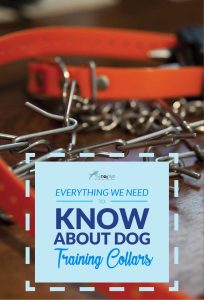Using training collars for dogs has long been a controversial subject.
Many dog owners and trainers have expressed strong concerns about how any type of dog training method using training collars may harm the animal, with more animal supporters asking to ban electric dog collars.
 In fact, some countries have already taken charge and banned these devices altogether, with more countries looking to follow suit.
In fact, some countries have already taken charge and banned these devices altogether, with more countries looking to follow suit.
Scotland, the UK, and other parts of Europe are currently considering a ban on shock collars for good.
A growing concern over the use of these electronic dog training devices, also known as shock collars, dog training e-collars, electric dog collars, is heavily researched in the scientific community.
So far, several studies have looked at the use of training collars for dogs and how they impact animals and their health.
A few scientific papers have concluded that shock collars negatively affect dogs and particularly raising their cortisol levels (a stress response hormone), with other studies demonstrating no negative effects on dogs.
Overall, it seems the research on shock collars is still inconclusive, but I'm going to take a closer look at it below.
Ideally, we still need a better design study to make a final assessment on the use of training collars for dogs and how this training method affects canines.
In the meantime, let's briefly observe what science has to say on the subject today.

Science on the use of training collars for dogs
 A lot of research is currently in progress with better-designed studies to make a final conclusion on the use of training collars for dogs and how they affect pets.
A lot of research is currently in progress with better-designed studies to make a final conclusion on the use of training collars for dogs and how they affect pets.
To this day, several studies looked at the stress levels of dogs on whom electronic collars were used.
Dog trainers and other experts have also expressed their opinion on the use of shock collars for dog training.
All in all, the research is still inconclusive, but more evidence is leaning towards shock collars causing additional stress in dogs.
One of the oft-quoted analysis concluded that these devices indeed cause distress in dogs:
“Our results indicate that the immediate effects of training with an e-collar give rise to behavioural signs of distress in pet dogs, particularly when used at high settings.”
Another study (PDF) found that the use of these devices may also impact dogs long-term:
“We concluded that shocks received during training are not only unpleasant but also painful and frightening. Furthermore, we found that shocked dogs are more stressful on the training grounds than controls, but also in a park.”
A third study have also found that shock collars alter canine's behavior and physiology:
In this context dogs showed responses to e-collar stimuli which were clearly discernible to a “blinded” observer, and showed changes in behaviour and physiology that other studies have interpreted as indications of aversive arousal or anxiety (e.g. Beerda et al 1998; Schilder and van der Borg 2004).
However, a few other studies concluded the opposite.
This fourth study has found no difference in cortisol level changes in dogs who were trained with shock collars as compared to other methods:
Overall, there was a significant time effect (P < 0.05) but no significant difference in plasma cortisol between the control, lemon spray and electronic collar groups (P > 0.05). Activity did not change significantly over time (P > 0.05).
And this fifth study that compared training collars for dogs with pinch collars and conditioned quitting signals actually found that shock collars are the most effective for training, giving the least amount of stress to dogs; pinch collars caused the most:
“All in all, considering the bodily reactions, pinch collar was found to be more distressful for dogs when comparing with the other methods. In accordance with the literature it seems possible to draw conclusions from bodily reactions to level of stress in dogs.”
This last study's design was less than ideal, however. It appears that the administrated shock collar stimulus was done with correct timing more reliably than the other two training cues.
This is a very important factor that may have given the shock collar an advantage.
This is yet another problem with the design of the study, which is actually a pattern that's prevalent among all the current research on shock collars.
So what does this all mean?
 First and foremost, current evidence clearly shows that the appropriate use of any training method, whether it involves any device or not, is the most important factor.
First and foremost, current evidence clearly shows that the appropriate use of any training method, whether it involves any device or not, is the most important factor.
Not the device itself.
While some devices may be more harmful to dogs than others, a dog trainer's actions will be the final determining factor.
Most dog shock collars vary in the production of electric stimuli, which is another factor that needs to be considered when assessing the use of these devices.
Unfortunately, many dog owners do misuse training collars with their dogs, and that alone could be a good enough reason to stop the use of these devices altogether.
Alas, dog trainers and owners who do use these devices with great care would hardly agree with a ban on shock collars.
Fortunately, not that many dog owners actually use electric collars for training dogs, and it also seems that more owners prefer an alternative, more humane methods to shock collars.
It's clear that the importance of accurate use of training methods using any type of device, as well as relying only on very high-quality and precise training collars for dogs has also been mentioned by many dog experts and dog trainers who stress the fact that e-collars are not as bad for dogs as the opposing side makes them sound.
In this interview, a well-known and experienced dog trainer provides more details on the subject.
Now let's get back to the studies.
 Since this has not been assessed, it's possible that the results from the first 3 studies showing the rise of stress levels in dogs are not directly associated with shock collars.
Since this has not been assessed, it's possible that the results from the first 3 studies showing the rise of stress levels in dogs are not directly associated with shock collars.
Instead, the correlation is in the process of training itself, and the fact that dogs are affected by environmental factors, as demonstrated in several other scientific papers.
Those may involve shock collars, citronella collars, a dog trainer giving commands, previous training, or otherwise “stressing” the animal, thereby ensuring a rise in cortisol levels.
For this reason, we definitely need another controlled, large sample study where several groups of dogs can be compared using all different types of training methods, as well as dogs that are not going through the process of training.
Other health factors must also be assessed and not just stress levels, since stress is generally a natural part of everyday life, both in humans and canines.
Regardless, while neither one of these studies are perfect in their structure, and we still need stronger evidence on whether training collars actually harm dogs, why and how they affect pets.
With that being said, the above results may be a good indication for dog owners to start looking into alternative methods of training dogs that do not involve electric shocks.
And so the debate continues.
It's time for a reality check, folks.
We have to recognize the truth: certain pet owners will continue to use any and every method of training dogs regardless of scientific evidence, as long as these devices are not banned.
With that in mind, we have to realize that fighting this through accusations and shouting will not accomplish anything.
Instead, what we can do is try to help provide resources and information for those who are yet to make a better decision for their dogs.
In my opinion, the best course of action is to educate dog owners on the use of controversial methods such as shock collars and point them in the direction of:
a) information and science on the use of shock collars;
b) most humane alternatives to these devices;
c) best and safest training collars for dogs;
d) advice on how to properly use these devices.
We've already discussed the current state of research on the use of training collars and linked them to the information of their proper use.
Now, let's take a look at the best alternatives as well as the safest shock collars that a dog owner can get today.
Training collars for dogs that are safe
 As discussed and noted by many dog experts, if you choose to use electronic training collars for dogs, then make sure that these devices are of the highest quality.
As discussed and noted by many dog experts, if you choose to use electronic training collars for dogs, then make sure that these devices are of the highest quality.
The reason is that the shock stimuli must be very precise and under your complete control.
That way you'll be able to use shock pulses accurately and as least as possible to avoid causing any unnecessary stress to your pet.
The best dog training collars, as noted in a well-research and detailed list in the link, are those made by reputable and very well-known brands that have a reputation to maintain.
These training collars for dogs are more expensive, but at least dog owners know exactly what they're getting.
Usually, dog trainers recommend several best-known brands that have been specializing in these devices for decades and developed collars that are as humane as a shock collar can possibly be.
Those brands are:
- Garmin
- Educator
- SportDog
- Dogtra
No other brands come even close to the quality of these four. Their prices usually range anywhere from $200 and up to $1000+.
Educator, in particular, is a new and innovative design that was manufactured with a 100% focus on causing the least amount of stress to dogs.
What's most important is for owners NOT to buy those cheap, China-made dog training collars that are available all over the internet. You can find those on Amazon at price ranges of around $20-30, which is insane, considering how quickly things can go wrong with electric devices that were manufactured for this little money.
Ultimately, if you choose to go this route, make sure you examine the instructions carefully, learn how to use the collar BEFORE you put it on your dog, and read all the literature on training dogs as well as dog training with shock collars that's available.
This is all for your canine's good, and let's face it, if you choose to employ a controversial method of training, you owe it to your dog to at least try to minimize the chance of stress as much as possible.
Alternatives to electronic training collars for dogs
There are several alternatives to shock collars, some of which have proven to be even more effective than your standard e-collar training. For example, a study has found that citronella anti-bark collars are about twice as more effective than electric anti-bark collars (88.9% vs 44.4%). Pair this with the fact that citronella has also no shock pulses, and it's a win-win.
Unfortunately, we have no scientific evidence of how effective citronella collars are for training dogs. On top of that, they aren't as popular, and purchasing them could be a hassle. One of the most commonly bought citronella dog collars is this one called PetSafe Remote Spray Trainer.
In terms of other alternatives, Top Dog Tips has previously published a great piece on this, listing all possible options to training canines for those who choose not to use shock training collars for dogs – No More Pain: Best Alternatives to Dog Shock Collars.
For further reading on the subject of training collars for dogs and humane methods of dog training, I recommend you read these articles as well:
- Everything You Need to Know About Humane Collars and Leashes
- Stay Humane: Myths and Facts About Electric Dog Collars
- How to Deal With Dog Aggression Without Training Collars
- Electronic Dog Training Collars: How to Use Them Safely
- How to Use Shock Collars in a Humane Fashion
Now it's your turn to pitch in on the matter!
Have you used electronic shock collars before? Are you pro or against the use of these devices, and why? We'd love to hear the opinions of other pet owners on this.
READ NEXT: Science-based Guide to Dog Shock Collars – What You Must Know
WANT TO SHARE THIS?
Disclosure: We may earn affiliate commissions at no cost to you from the links on this page. This did not affect our assessment of products. Read more here and find full disclosure here.















